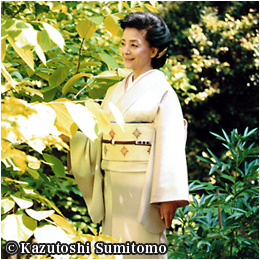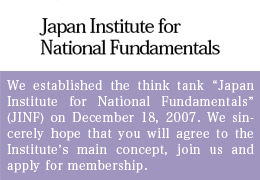Japan Should Achieve Restoration of the Its Beautiful Land by First De-Radiating Its Environment
The disaster at the nuclear power plant in Fukushima, northeast Japan, transformed Japan from an “honor roll student” of the peaceful use of atomic energy to an “ex-convict” overnight, deplores Hajimu Yamana, a professor with the Research Reactor Institute of Kyoto University, and one of the nation’s leading authorities on radio chemistry. What is vital for Japan at this juncture, emphasizes Professor Yamana, is do everything possible to make sure Fukushima doesn’t become a second Chernobyl, and, plainly speaking, restore “Fukushima the Beautiful.”
The prefecture, admired across Japan over the centuries for the natural beauty of its land and sea, as well as the legendary human warmth of its inhabitants, now appears to have become a synonym for nuclear disaster. This unfortunate situation must be rectified by all means. All Japanese must join hands in restoring and rejuvenating this once beautiful prefecture at all costs - on behalf of the people of Fukushima, as well as throughout the rest of Japan and, in fact, the world.
Needless to say, Fukushima is markedly different from Chernobyl. For instance, the amount of radiation emitted into the environment in Fukushima is about one tenth that of Chernobyl; the level of radiation the residents have been exposed to has so far remained low; and not a single soul has died of radiation. Prof. Yamana is confident that thyroid cancer in children, attributable to the intake of radiation-tainted food, can be brought as close as possible to zero.
However, in order to achieve this, it is critically important to remove from the environment radioactive particles discharged from the crippled nuclear power plant. Explains Prof. Yamana:
“In cooperation with Fukushima Prefecture, a study group from Kyoto University has been driving across various regions of the prefecture with radioactive counters on board, recording radiation levels every ten seconds along the way. While there are stretches of highly contaminated areas spreading like a belt as we drive on, just a little distance away, there are areas with markedly low radiation levels. Japan is at a critical juncture now, having to assemble the best minds we can find to restore the environment to its original level of safety. We can do this by precisely grasping the pattern of distribution of radioactive particles that have spread in highly complex ways, reflecting peculiar climatic and topographic conditions.”
According to the standards set by the International Commission on Radiological Protection (ICRP), the permissible level of radiation exposure for habitation, when the Fukushima disaster is finally resolved, will be at an equivalent of between 1 and 20 millisieverts a year. Despite the fact that the ICRP has set the ceiling at this level, however, every effort should be made to lower the level as much as possible. Particularly worrisome are the effects of radiation on little children. As was notable in the Chernobyl disaster, infants and little school children are especially prone to thyroid disorders. That is precisely why truly effective measures must be meted out as swiftly as possible to remove radiation contaminating the environment.
Introducing Measures That Can Still Work If Immediate Action Is Taken
On May 11, the Ministry of Education, Culture, Sports, Science, and Technology, informed the prefectural education board of Fukushima of the following measures recommended to ensure the safety of school grounds where children spend long hours daily: (1) removing radiation-tainted topsoil and replacing it with a layer of soil just underneath; or, (2) digging a pit elsewhere and burying the topsoil there. Explains Prof. Yamana:
“There are two basic ways of dealing with contaminated soil, the first one being removing topsoil and dumping it into a pit. In this case, an area is chosen for the pit which can be closely managed over years; elaborate measures are taken to prevent ground water from seeping into it; sealing it with a very thick layer of surface soil, and planting plants over it. This we call a ‘straight burial method,’ which actually is one of the two measures proposed by the ministry.”
However, this second measure recommended by the ministry, the so-called “straight burial method,” becomes a more demanding task, the greater the amount of topsoil that has to be removed. And yet, according to Prof. Yamana, this measure is workable - if enforced immediately.
“Because it is believed that the cesium will still remain within the first one centimeter of the surface of the ground as of the end of this month, only about three centimeters of topsoil would need to be placed at this point. After more rainfall and/or a long period of indecision by the government, the cesium will tend to gradually sink deeper and deeper into the ground. Commonsense dictates that the removing of topsoil should be done as soon as possible.”
However, the ministry also recommends measure (1) - replacing topsoil with a layer of soil immediately underneath. Which suggests that 10 centimeters of topsoil be removed and replaced with 20 centimeters of soil immediately underneath. The ministry claims such a measure will reduce the radiological dosage on the surface by 90 percent. But, in fact, replacing topsoil with a thicker layer of soil just below in this fashion doesn’t solve anything. Because soil tainted by cesium still remains hazardous despite such replacement, the two layers of soil will eventually have to be dumped together into a pit that has to be created elsewhere. If quick action is taken now, only three centimeters of soil can be removed, and the pit required will be much smaller. But, by following the ministry’s instructions, school authorities involved will end up mixing 30 centimeters of soil, which means they will have ten times more soil to remove than if they act immediately on their own. The ministry’s instructions are mistaken in this respect.
Another workable method proposed by Prof. Yamana, although somewhat expensive, is cleansing contaminated soil with water. Cesium can be washed away by mechanically mixing water with soil. Soil thus cleansed will be returned to the original ground, while cesium, dissolved into water, will be solidified and dumped into a pit - the so-called “pit treatment.”
Much of radioactive waste produced by nuclear power stations today is solidified, sealed in drums, and stored and managed in ferroconcrete underground chambers deep down.
While having knowledge of certain methods of dealing with radiation, those actively involved in the actual day-to-day operations in a wide range of local governments across the northeast are actually faced with a major problem. That is, there are no laws in Japan involving restoration of contaminated environments, nor is there any pertinent government instruction or guidance. Prof. Yamana points out sternly:
“To begin with, I am afraid the government absolutely lacks a concerted vision committing itself to restoring the battered land. This includes the Prime Minister’s office as well as the Ministry of Education, Culture, Sports, Science and Technology, and the Ministry of Economy, Trade and Industry.”
Actually, neither the Law on the Regulation of Nuclear Source Material, Nuclear Fuel Material, and Reactors nor the Soil Contamination Countermeasures Law refers to radioactive particles.
Clearly, Japan needs new legislation to make up for such appalling flaws in legal preparedness. However, for reasons that baffle one, the Democratic administration headed by Prime Minister Naoto Kan is not taking any action. In fact, it looks as though the party has no interest in taking action. The only thing discernible is the party’s readiness to pass the buck to local governments, obviously expecting them to foot all the bills on their own.
Restoring “Fukushima the Beautiful”
Local governments across the affected prefectures must in fact take effective measures urgently to thwart health hazards, especially to little children. Six municipalities in Fukushima already have submitted a petition to Yoshiaki Takaki, Minister of Education, requesting the state to make clear the standards for soil treatment and extend monetary assistance for their efforts to remove and dump tainted soil. In sharp contrast to the minister’s obvious reluctance to commit to anything other than “fully consulting with other ministries and agencies,” roughly 50 day-care centers, grade and junior high schools in Koriyama City, and one kindergarten and two grade schools in Date City have completed operations to remove radiation-tainted topsoil. Unable to immediately dispose of the soil thus removed, however, these institutions are provisionally keeping the soil on the edges of their grounds, covered by plastic sheets.
So far, these local municipalities have tried their best to manage to accomplish this much in their defense of children against radiation. But the problems are not just limited to school grounds. Farm land, grazing land, and forests all call for immediate measures to cope with radiation. Prof. Yamana believes restoration of “Fukushima the Beautiful” is certainly doable by removing the soil in rice paddies, farm land, and grazing land. However, a major problem remains with forests. He explains:
“In forests, radioactive particles generally cling to fallen leaves, but the vastness of the forests presents formidable challenges in picking up the leaves.Because of the danger of radioactive exposure, one would greatly hesitate to use manual labor, while picking up leaves by using machines would understandably be quite difficult. Further, if machines are used and end up completely removing the dead leaves, there is a great possibility that the circulation of organic matter in the forests would be terminated, seriously impairing the forests themselves.
“De-radiation of forests is a vast problem with serious bearings on the fate of the forests, as well as the seas. I believe this matter will have to be grappled with as a vital national project, by pulling together all the ideas and opinions of experts from across Japan.”
To prove that Japan is not Russia and Fukushima not Chernobyl, all the people of the villages, cities, and towns of Fukushima including the areas that are now highly contaminated and designated as no-entry zones, must work to their utmost to achieve restoration with methods and efforts proving exemplary to the international community. Prime Minister Kan, hopelessly incapable of laying down an even fundamental road map for environmental restoration, happily left on May 24th for France to attend the 37th G8 summit. Shortly before departure, Kan jovially told reporters he would declare to the world “how Japan is determined to rebuild.” But given the challenges we face and the timing of his trip, I must admit his vain smile left me with a very empty feeling.
(Translated from “Renaissance Japan” column no. 462 in the June 2, 2011 issue of The Weekly Shincho.)








